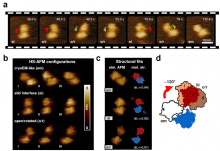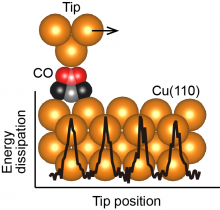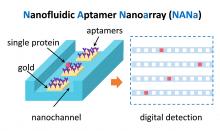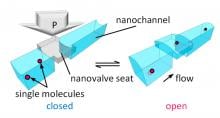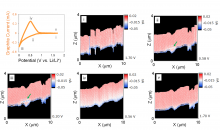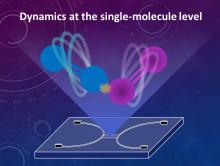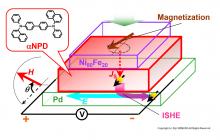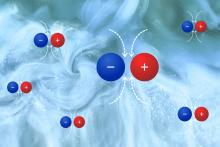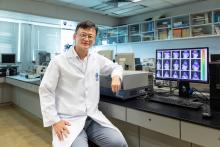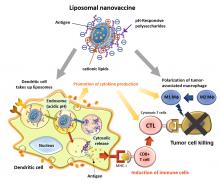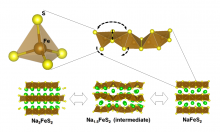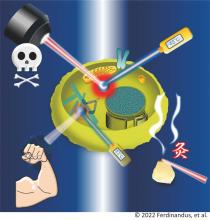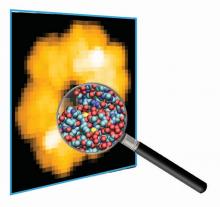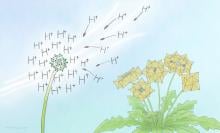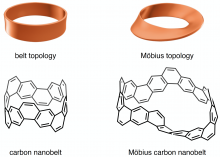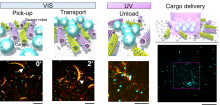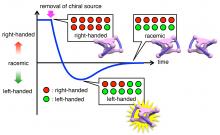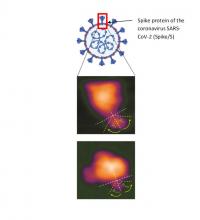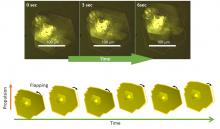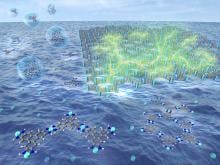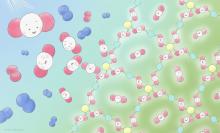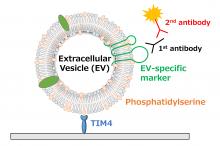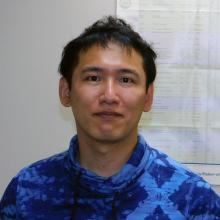Chemistry Nanotechnology
News
22 Feb 2024
Researchers from Nano Life Science Institute (WPI-NanoLSI), Kanazawa University report in Nature Communications that TMEM16F, a transmembrane protein that facilitates the passive movement of phospholipids and ions across membranes, explores a larger conformational landscape than previously thought to perform its unique functions. The finding refines our molecular understanding of crucial physiological processes such as blood coagulation and COVID-19 pathogenesis, and highlights the importance of probing membrane proteins in native-like environments.
03 Oct 2023
Friction, an everyday phenomenon, has perplexed scientists for centuries. Though extensively researched, our understanding remains fragmented, primarily due to the multifaceted interactions that span across varying scales. Achieving an accurate grasp of the precise contact conditions between objects has been a longstanding challenge, a
feat recently made possible through advancements in scanning probe microscopy.
23 Jun 2023
An international team led by Professor Yan Xu from Osaka Metropolitan University has developed a groundbreaking nanofluidic device, named NANa, capable of stochastically capturing and digitally detecting individual proteins at cellular concentrations. This tool, vital for precision medicine, is designed to handle tiny volumes equivalent to a single cell's contents and can identify single biomolecules even in high-concentration environments. The team plans to conduct further demonstrations using actual cell samples and explore the integration of this tool with AI and biological big data. This research could potentially revolutionize personalized disease prevention and treatment.
01 May 2023
A joint research group at Osaka Metropolitan University has succeeded in regulating the flow of single molecules in solution by opening and closing the nanovalve mounted on the nanofluidic device by applying external pressure. The research group fabricated a device with a ribbon-like, thin, soft glass sheet on the top, and at the bottom a hard glass substrate having nanochannels and nanovalve seats. By applying external pressure to the soft glass sheet to open and close the valve, they succeeded in directly manipulating and controlling the flow of individual molecules in solution. They also observed an effect of fluorescence signal amplification when single fluorescent molecules are confined in the tiny nanospace inside the valve. The effect can be ascribed to the nanoconfinement, which suppresses the random motion of the molecules.
20 Mar 2023
Researchers at Kanazawa University report in JACS Au how they have developed operando scanning ion conductance microscopy to allow simultaneous measurements of changes in the anode surface topography of a lithium ion battery during use, as well as the varying ion concentration with depth. Combining both types of information should help researchers evaluate the correlation between the two to design better batteries.

13 Mar 2023
Researchers at Kanazawa University report in ACS Nano how high-speed atomic force microscopy can be used to study the biomolecular mechanisms underlying gene editing.

28 Feb 2023
Researchers at Kanazawa University report in Nano Letters the discovery of a biomolecular dynamical process likely relevant to gene expression. The process, revealed by means of high-speed atomic force microscopy, involves DNA and its packaging molecules.
21 Feb 2023
Researchers from Osaka Metropolitan University have developed principles and technologies of nanofluidic devices to freely manipulate nanomaterials, biomaterials, and molecules at the single-molecule level using fundamental technologies such as nanofluidic processing, functional integration, and fluidic control and measurement, which has pioneered the way to integrate various fields under nanofluidics.
24 Jan 2023
A research group, at the Osaka Metropolitan University Graduate School of Engineering, has succeeded in measuring spin transport in a thin film of αNPD molecules—a material well-known in organic light emitting diodes—at room temperature. They found that this thin molecular film has a spin diffusion length of approximately 62 nm, a length that could have practical applications in developing spintronics technology. In addition, while electricity has been used to control spin transport in the past, the thin molecular film used in this study is photoconductive, allowing spin transport control using visible light.
12 Dec 2022
Researchers at The University of Tokyo show how including the effects of the surrounding water during the aggregation of charged particles can improve the accuracy of simulations, which may help elucidate biological self-assembly
28 Nov 2022
A Hong Kong Baptist University (HKBU) collaborative research team has synthesised a nanoparticle named TRZD that can perform the dual function of diagnosing and treating glioma in the brain. It emits persistent luminescence for the diagnostic imaging of glioma tissues in vivo and inhibits the growth of tumour cells by aiding the targeted delivery of chemotherapy drugs. The nanoparticle offers hope for the early diagnosis and treatment of glioma, especially cerebellar glioma, which is even harder to detect and cure with existing methods.
31 Oct 2022
A research group at Osaka Metropolitan University has developed a drug delivery system that activates a strong cellular immune response to attack cancer cells, using one-tenth of the amount of antigen needed in the group’s previous work. By incorporating positively charged cationic lipids into liposomes and adding negatively charged pH-responsive polysaccharides to the surface, the research group increased the uptake efficiency of liposomes encapsulating cancer antigens by dendritic cells by approximately five times, which increased cytokine production by about 100 times. This increased M1-type macrophages, which activate cancer immunity, and decreased M2-type macrophages, which promote cancer growth.
11 Oct 2022
Osaka Metropolitan University scientists have successfully developed a new positive electrode material Na2FeS2, consisting of sodium, iron, and sulfur. During testing, batteries using the Na2FeS2 positive electrode had a high energy storage capacity and could be charged and discharged for more than 300 cycles. Because the Na2FeS2 is made of abundant inexpensive elements, it is expected to be used in all-solid-state sodium batteries with higher capacity and lower costs.
08 Aug 2022
Researchers at Kanazawa University report in ACS Nano the development of a nanoparticle that acts as a heater and a thermometer. Inserting the nanoparticle in living cells results in a heat spot that, by switching it on and off, enables the controlled modulation of local cellular activities.
20 Jun 2022
Atomic force microscopy (AFM) allows to visualize the dynamics of single biomolecules during their functional activity. All observations are, however, restricted to regions accessible by a fairly big probing tip during scanning. Hence, AFM images only the biomolecular surface with limited spatial resolution, missing important information required for a detailed understanding of the observed phenomena.
18 Jun 2022
The molecule is unusual and has ‘great potential’ in catalysis, conduction and other applications.
19 May 2022
Scientists have synthesized the first belt-shaped molecular nanocarbon with a twisted Möbius band topology—a Möbius carbon nanobelt—that paves the way for the development of nanocarbon materials with complex topological structures.
20 Apr 2022
In a global first, scientists have demonstrated that molecular robots are able to accomplish cargo delivery by employing a strategy of swarming, achieving a transport efficiency five times greater than that of single robots.
12 Apr 2022
Researchers at The University of Tokyo used a hybrid of Monte Carlo and molecular dynamics simulations to predict the self-assembly of charged Janus particles, which may lead to biomimetic nanostructures that can assemble like proteins
11 Apr 2022
Milling rice to separate the grain from the husks, produces about 100 million tons of rice husk waste globally each year. Scientists searching for a scalable method to fabricate quantum dots have developed a way to recycle rice husks to create the first silicon quantum dot LED light. Their new method transforms agricultural waste into state-of-the-art light-emitting diodes in a low-cost, environmentally friendly way.
10 Mar 2022
Researchers at Kanazawa University report in Proceedings of the National Academy of Sciences a responsive molecular system that, through chemical reactions, inverses its chirality before becoming racemic.
10 Jan 2022
Unveiling substructures at the edge of the Galaxy, Nanodiamonds key to efficient hydrogen purification, How SARS-CoV-2 evades our immune system, A Zika hijacking with devastating impacts & Finding the right story for your audience, all in the January Editor's Choice.
16 Dec 2021
In a study published in Nature Energy this month, researchers led by Kyoto University’s Institute for Integrated Cell-Material Sciences (iCeMS) describe how nanodiamond-reinforced composite membranes can purify hydrogen from its humid mixtures, making the hydrogen generation processes vastly more efficient and cost-effective.
15 Dec 2021
In a recent study published in the Journal of Extracellular Vesicles researchers from Kanazawa University have visualized structural changes on the surface of SARS-CoV-2 that enable it to enter human cells.
29 Nov 2021
Synthesized microrobots that are capable of converting their mechanical motion into a means of self-propulsion in water have been developed by scientists at Hokkaido University.
25 Oct 2021
Spontaneous wide-area spreading of oil on water inspires a facile energy-saving route of crafting electrically conductive nanostructures for future sensor/energy devices
05 Oct 2021
Researchers in Japan have found an energy-efficient way to convert the chief greenhouse gas carbon dioxide (CO2) into useful chemicals. Using the method, CO2 is transformed into structures called metal-organic frameworks (MOFs), suggesting a new and simpler route to dispose of the greenhouse gas to help tackle global warming.
02 Sep 2021
Researchers at Kanazawa University describe in Scientific Reports the identification of small compounds that can regulate the cellular production of extracellular vesicles — nanocontainers transporting biomolecules between cells. Such compounds hold promise for use in therapies for various diseases.
27 Jul 2021
Adding lead and calcium to an industrial catalyst dramatically improves its ability to support propylene production at very high temperatures, making it stable and active for a month.
25 Jun 2021
Perovskite colloidal quantum dots (Pe-CQDs) are highly promising nanocrystals for optoelectronic applications. However, the size of the crystals should ideally be equal to ensure a consistent energy landscape. In a recent study, scientists clarified the relationship between differences in particle size—polydispersity—and the optoelectronic characteristics of Pe-CQDs. They showed that using equally sized, or ‘monodisperse,’ quantum dots results in markedly better performance in Pe-CQD solar cells, paving the way for future optoelectronic devices.
Events
Sorry, nothing coming up for this discipline
Researchers
Professor Shinya Maenosono leads his research group at Japan Advanced Institute of Science and Technology (JAIST). His research in JAIST has focused on two main areas of interest in the field of materials chemistry and nanotechnology. The first area involved wet chemical synthesis of semiconductor nanoparticles with controlled size, shape and composition for energy conversion device applications. The second area has focused on the synthesis and bioapplication development of monometallic and alloyed multimetallic nanoparticles.
Lecturer in Forensic Chemistry field. Actively engaging in agricultural waste upcycling into nanatechnology products.
A Tenured Professor at the Institute of Space Technology (Pakistan), Dr. Shabbir is working on Polymer based Nanomaterials for water treatment, food safety, nano-drug delivery systems, solar cells and carbon dioxide capture.
Madoka Ono is an associate professor at the Research Institute for Electronic Science/Green Nanotechnology Research Center at Hokkaido University and is the principal researcher at AGC Inc. Materials Integration Laboratories.
A pioneering researcher in Systems Chemistry for autonomous behavior in multi-molecular systems. The interdisciplinary field of chemistry and physics can be contributes the development in micro-robotics and comprehension of origin-of-life.
Dr. Leung is an Associate Professor and Programme Director at the Department of Chemistry, The Hong Kong Baptist University (HKBU), Hong Kong SAR, P. R. China. He concurrently holds the Honorary Associate Professorship at the Faculty of Dentistry, The University of Hong Kong (HKU). He is a Chartered Scientist, Chartered Chemist of the Royal Society of Chemistry in UK and a member in the State Key Laboratory of Environmental and Biological Analysis at HKBU. He was elected as a Founding Member of The Hong Kong Young Academy of Sciences. His research interests are in the field of supramolecular chemistry, organic materials catalysis, nanoscience, and nanomedicine.
Dr. Omachi is Associate Professor, Research Center for Materials Science, Nagoya University
Giants in history
Sorry, nothing coming up for this discipline


